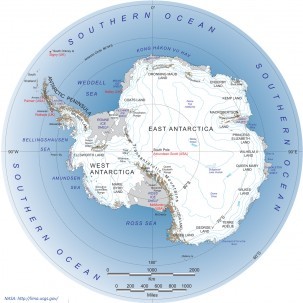Exploring Beneath Earth’s Changing Ice Sheets
If just the West Antarctic Ice Sheet were to melt, it would raise global sea level by 6 meters. That’s more than a theoretical problem. West Antarctica is losing ice mass, and scientists are worried.
The fate of the ice sheets has a direct impact on populations worldwide: as the land-based ice melts, it raises sea level, and that can threaten coastal communities and economies.
[youtube]https://www.youtube.com/watch?v=F0B3O82Zu6Y[/youtube]
Antarctica holds about 27 million cubic kilometers of ice that is constantly flowing, pushed by its own weight and pulled by gravity. If just part of that ice – the West Antarctic Ice Sheet – were to melt into the ocean, it would raise global sea level by 6 meters. That’s more than a theoretical problem. West Antarctica is losing ice mass, and scientists are worried.
Warming air temperatures and warming water both play a role. So does geography.
“As our planet warms, the polar regions are warming faster than anywhere else on our planet and the ice sheets are changing. They’re melting and they’re sliding faster toward the ocean. Global sea level is going up, and we expect that to go up faster as more of the ice melts,” said Robin Bell, a glaciologist at Columbia University’s Lamont-Doherty Earth Observatory who is leading the Changing Ice, Changing Coastlines Initiative with paleoclimatologist Maureen Raymo.

To understand how a massive ice sheet can become destabilized, we need to understand the structure of the land that holds the ice on Antarctica today.
Bell and her colleagues engineered a way to do that in some of the most remote regions on the planet. They took radar and other technology normally used to study the sea floor and attached it to a C-130 cargo plane in a capsule called the IcePod. By flying over the ice sheets – as they’re doing right now over Antarctica’s giant Ross Ice Shelf – they can see where the ice enters the ocean and map the ice layers and the terrain hidden beneath it.
Ice shelves, like Ross, are particularly important to the West Antarctic Ice Sheet’s stability. They jut out over the water ahead of flowing glaciers and slow the glaciers’ flow into the ocean. The biggest threat to ice shelves is warmer water brought in by ocean currents that flows low along the continental shelf and eat away at the base of the ice shelf. This line where ice, water and rock meet is called the grounding line. As the ice erodes, the grounding line moves inland, and geography comes into play: In West Antarctica, most ice shelves are on slopes that slant inward toward the center of the continent. As the grounding line moves inland and into deeper water, the ice shelf becomes unstable and can break apart.
That happened in 2002, when the Larson B Ice Shelf broke off from Antarctica and disappeared over the span of a few weeks. The glaciers the ice shelf had held back started flowing at eight times their previous speed. It was a wake-up call, as Bell explains in the video above.
The Ross Ice Shelf is much larger than Larson B and is an outlet for several major glaciers from the West Antarctic Ice Sheet. And it’s only one of the areas of West Antarctica that has scientists concerned.
To the west of the Ross Ice Shelf, on the Amundsen Sea, scientists see evidence that the massive Thwaites and Pine Island Glaciers are also moving faster as their grounding lines recede. At the Pine Island Glacier, the grounding line receded about 31 kilometers between 1992 and 2011, contributing to the glacier’s increasing speed and ice loss starting around 2002. One recent study used computer modeling to look at what might happen and suggests that if the Amundsen Sea glaciers were destabilized, a large part of the West Antarctic Ice Sheet would discharge into the ocean. Another study found that the rate of thinning in West Antarctic ice shelves had increased 70 percent over the past decade based on satellite data, and some ice shelves lost as much as 18 percent of their volume between 1994 and 2012. (To learn more about changing ice sheets, look for the Polar Explorer app being released by Lamont-Doherty Earth Observatory this fall.)
These and other findings led the National Academies of Sciences to issue a recommendation this summer that the U.S. Antarctic Program at the National Science Foundation make changing ice sheets and their contribution to sea level rise one of its top research goals for the next 10 years, particularly in West Antarctica. The fate of the ice sheets has a direct impact on humanity: as land-based ice melts, it raises sea level, and that can threaten coastal communities and economies worldwide.
“Our planet’s large ice sheets contain secrets that will be uncovered by studies of the changing ice and changing coastlines,” Bell said. “New expeditions to poles to decode how they work what makes them flow deform and melt while new studies of ancient shoreline will inform how fast the change occurred in the past. We envision a new phase of exploration and discovery to inform our future.”
Learn more about West Antarctica and the impact of rising temperatures on marine life, part of a video series.
